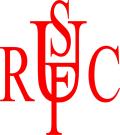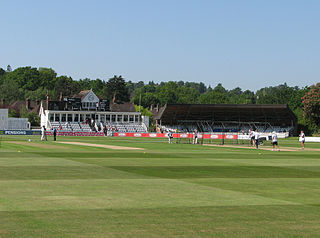Related Research Articles

Kent County Cricket Club is one of the eighteen first-class county clubs within the domestic cricket structure of England and Wales. It represents the historic county of Kent. A club representing the county was first founded in 1842 but Kent teams have played top-class cricket since the early 18th century, and the club has always held first-class status. The current Kent County Cricket Club was formed on 6 December 1870 following the merger of two representative teams. Kent have competed in the County Championship since the official start of the competition in 1890 and have played in every top-level domestic cricket competition in England. The club's limited overs team is called the Kent Spitfires after the Supermarine Spitfire.
Stockport Cricket Club is situated on Beech Road, Cale Green, Stockport in the North West of England. The club has three senior sides and a junior section. The first and second teams play in the Cheshire Cricket League, while the third team play in the Cheshire County Cricket League.

Broadhalfpenny Down is a historic cricket ground in Hambledon, Hampshire. It is known as the "Cradle of Cricket" because it was the home venue in the 18th century of the Hambledon Club, but cricket predated the club and ground by at least two centuries. The club is in the parish of Hambledon close to the neighbouring parish of Clanfield. The club took the name of the neighbouring rural village of Hambledon, about 2.7 miles away by road.
In the years from 1726 to 1750, cricket became an established sport in London and the south-eastern counties of England. In 1726, it was already a thriving sport in the south east and, though limited by the constraints of travel at the time, it was slowly gaining adherents in other parts of England, its growth accelerating with references being found in many counties. Having been essentially a rural pastime for well over a century, cricket became a focus for wealthy patrons and gamblers whose interests funded its growth throughout the 18th century.

Tunbridge Wells Football Club is a football club based in Royal Tunbridge Wells, Kent, England. They are currently members of the Southern Counties East League Premier Division. They play their home games at Culverden Stadium. The club is affiliated to the Kent County Football Association.

Thamesmead Town Football Club was a football club originally based in Thamesmead in south-east London before moving to Dartford in 2017. They joined the Kent League in 1991 and reached the 5th round of the FA Vase in the 1995–96 season. In the 2007–08 season, they were champions of the Kent League Premier Division and were promoted to the Isthmian League Division One North for the 2008–09 season. In the 2012–13 season, they won the Division One North play-offs and were promoted to the Isthmian League Premier Division for the first time in their history, but were relegated back after finishing 22nd the following season. The club announced it was folding in October 2018 and subsequently closed down.

Sheppey United F.C. is a football club based on the Isle of Sheppey in Kent. The club are members of the Isthmian League South East Division and play at Holm Park. The club is affiliated to the Football Association and is an FA Charter Standard club.

The Vine Cricket Ground, also known as Sevenoaks Vine, is one of the oldest cricket venues in England. It was given to the town of Sevenoaks in Kent in 1773 by John Frederick Sackville, 3rd Duke of Dorset (1745–1799) and owner of nearby Knole House. The land is thought to have possibly been used as a vineyard for the Archbishops of Canterbury.

Swansea Uplands RFC is a rugby union club based in Upper Killay, Swansea, Wales, who play in the WRU Swalec Leagues. They are currently in Division 3 West A.

The Nevill Ground is a cricket ground at Royal Tunbridge Wells in the English county of Kent. It is owned by Tunbridge Wells Borough Council and is used by Tunbridge Wells Cricket Club in the summer months and by Tunbridge Wells Hockey Club in the winter. It was opened in 1898 and was first used by Kent County Cricket Club in 1901. The county has held the Tunbridge Wells Cricket Week on the ground annually, despite a suffragette arson attack which destroyed the pavilion in 1913.

Chelmsford Hockey Club is a field hockey club based in Chelmsford, Essex, England. The club's home ground is at Chelmer Park, with a capacity of 100 seats and numerous standing.

The Crabble Athletic Ground, also known as simply Crabble, or The Crabble is a football stadium located in the northern Dover suburb of River, Kent. It was the home of the various incarnations of Dover F.C. from 1931 until the club folded in 1983. Since then it has been the home of Dover Athletic F.C., and it was also the temporary home of Margate F.C. between 2002 and 2004, when the club's Hartsdown Park stadium was being redeveloped. The stadium has two seated stands and two covered terraces and holds a total of 5,745 fans, although in the past, crowds larger than that figure could be accommodated. It also has a clubhouse, which the club completely redeveloped in 2008.

The Dripping Pan is a football stadium in Lewes, England. It has been home to Lewes F.C. since their foundation in 1885. It had previously been used by Lewes Priory Cricket Club, though the ground itself had been used by the people of Lewes as an area for recreation, including athletics, as far back as written records exist.
Sződliget is a small town in Pest county, Hungary.

Cheriton Road is a complex of sports grounds at Folkestone in the English county of Kent. The complex includes football pitches, a cricket ground, hockey pitches, netball courts and an indoor sports facility. It includes the home ground of Folkestone Invicta F.C., known as The BuildKent Stadium for sponsorship reasons, and the Three Hills Sports Park which includes the home grounds of Folkestone Cricket Club and Folkestone Optimist Hockey Club. The cricket ground, which was previously called the Cheriton Road Sports Ground, was used by Kent County Cricket Club for top level cricket matches.

The Salisbury and South Wiltshire Sports Club is a sports ground in Salisbury, Wiltshire, England, which is used for cricket, football, hockey and other sports.

Higher Common Ground is a cricket ground on Tunbridge Wells Common in the town of Royal Tunbridge Wells in Kent. It was used as a ground by Kent County Cricket Club in the 19th century and is the home ground of Linden Park Cricket Club.
Hesketh Park is a cricket ground in Dartford in Kent. The ground is the home of Dartford Cricket Club, one of the oldest cricket clubs in the United Kingdom. The ground was established at the beginning of the 20th century and has been used as a first-class cricket venue by Kent County Cricket Club.
B. M. Close's Ground was a cricket ground at Southborough in the English county of Kent. The ground was established in 1859 by Robert Winnifrith on land owned by George Newnham of Horsemunden Farm and was described in 1862 as "one of the best cricket grounds in Kent". The first recorded match on the ground was in 1859, when a Tunbridge Wells side played a New All-England Eleven.
Tunbridge Wells Cricket Club is an amateur cricket club in Royal Tunbridge Wells, Kent, England. It was founded in 1782 and they play their home matches at the Nevill Ground. As of 2019 they play in the Kent Cricket League Premier Division.
References
- ↑ Harris, Mary (29 June 2019). "Dog walkers damaging cricket ground are 'putting players' safety at risk'". KentLive. Retrieved 20 October 2022.
- ↑ Cox, Richard William (2003). British Sport: Local histories. Psychology Press. p. 74. ISBN 978-0-7146-5251-1.
- ↑ Tunbridge Wells in Old Photographs. Sutton. 1991. p. 86. ISBN 978-0-86299-663-5.